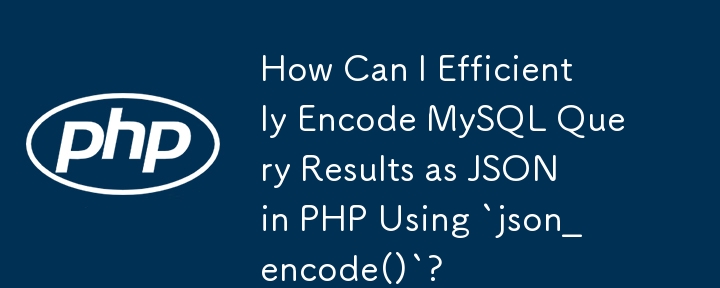 Backend Development
Backend Development
 PHP Tutorial
PHP Tutorial
 How Can I Efficiently Encode MySQL Query Results as JSON in PHP Using `json_encode()`?
How Can I Efficiently Encode MySQL Query Results as JSON in PHP Using `json_encode()`?
How Can I Efficiently Encode MySQL Query Results as JSON in PHP Using `json_encode()`?
Dec 18, 2024 am 08:21 AM
JSON Encoding MySQL Results with json_encode()
json_encode() is a handy function in PHP that converts data into JSON format. For MySQL query results, there are various approaches to use this function.
Do you need to manually iterate through each row or can you apply json_encode() to the entire result object?
Using Iteration
For older PHP versions, the most straightforward method is to iterate through each row in the result set using a while loop. Here's an example:
<?php
$sth = mysqli_query($conn, "SELECT ...");
$rows = array();
while ($r = mysqli_fetch_assoc($sth)) {
$rows[] = $r;
}
print json_encode($rows);
?>
Note that json_encode() expects associative arrays (key-value pairs), so mysqli_fetch_assoc() fetches the rows as associative arrays.
Using mysqli_fetch_all() (Modern Approach)
Modern PHP versions have a built-in mysqli_fetch_all() function that allows you to fetch all rows in one go. This simplifies the encoding process:
<?php $result = mysqli_query($conn, "SELECT ..."); $rows = mysqli_fetch_all($result); // list arrays with values only in rows // Or, for associative arrays: $rows = mysqli_fetch_all($result, MYSQLI_ASSOC); print json_encode($rows); ?>
Additional Notes
- json_encode() requires PHP version 5.2 or later.
- The php-json package is also necessary.
- If you encounter any issues, ensure that you have enabled JSON support in your PHP configuration.
The above is the detailed content of How Can I Efficiently Encode MySQL Query Results as JSON in PHP Using `json_encode()`?. For more information, please follow other related articles on the PHP Chinese website!

Hot AI Tools

Undress AI Tool
Undress images for free

Undresser.AI Undress
AI-powered app for creating realistic nude photos

AI Clothes Remover
Online AI tool for removing clothes from photos.

Clothoff.io
AI clothes remover

Video Face Swap
Swap faces in any video effortlessly with our completely free AI face swap tool!

Hot Article

Hot Tools

Notepad++7.3.1
Easy-to-use and free code editor

SublimeText3 Chinese version
Chinese version, very easy to use

Zend Studio 13.0.1
Powerful PHP integrated development environment

Dreamweaver CS6
Visual web development tools

SublimeText3 Mac version
God-level code editing software (SublimeText3)

Hot Topics
 How do I implement authentication and authorization in PHP?
Jun 20, 2025 am 01:03 AM
How do I implement authentication and authorization in PHP?
Jun 20, 2025 am 01:03 AM
TosecurelyhandleauthenticationandauthorizationinPHP,followthesesteps:1.Alwayshashpasswordswithpassword_hash()andverifyusingpassword_verify(),usepreparedstatementstopreventSQLinjection,andstoreuserdatain$_SESSIONafterlogin.2.Implementrole-basedaccessc
 How do I stay up-to-date with the latest PHP developments and best practices?
Jun 23, 2025 am 12:56 AM
How do I stay up-to-date with the latest PHP developments and best practices?
Jun 23, 2025 am 12:56 AM
TostaycurrentwithPHPdevelopmentsandbestpractices,followkeynewssourceslikePHP.netandPHPWeekly,engagewithcommunitiesonforumsandconferences,keeptoolingupdatedandgraduallyadoptnewfeatures,andreadorcontributetoopensourceprojects.First,followreliablesource
 What is PHP, and why is it used for web development?
Jun 23, 2025 am 12:55 AM
What is PHP, and why is it used for web development?
Jun 23, 2025 am 12:55 AM
PHPbecamepopularforwebdevelopmentduetoitseaseoflearning,seamlessintegrationwithHTML,widespreadhostingsupport,andalargeecosystemincludingframeworkslikeLaravelandCMSplatformslikeWordPress.Itexcelsinhandlingformsubmissions,managingusersessions,interacti
 How to set PHP time zone?
Jun 25, 2025 am 01:00 AM
How to set PHP time zone?
Jun 25, 2025 am 01:00 AM
TosettherighttimezoneinPHP,usedate_default_timezone_set()functionatthestartofyourscriptwithavalididentifiersuchas'America/New_York'.1.Usedate_default_timezone_set()beforeanydate/timefunctions.2.Alternatively,configurethephp.inifilebysettingdate.timez
 How do I install PHP on my operating system (Windows, macOS, Linux)?
Jun 20, 2025 am 01:02 AM
How do I install PHP on my operating system (Windows, macOS, Linux)?
Jun 20, 2025 am 01:02 AM
The method of installing PHP varies from operating system to operating system. The following are the specific steps: 1. Windows users can use XAMPP to install packages or manually configure them, download XAMPP and install them, select PHP components or add PHP to environment variables; 2. macOS users can install PHP through Homebrew, run the corresponding command to install and configure the Apache server; 3. Linux users (Ubuntu/Debian) can use the APT package manager to update the source and install PHP and common extensions, and verify whether the installation is successful by creating a test file.
 How do I validate user input in PHP to ensure it meets certain criteria?
Jun 22, 2025 am 01:00 AM
How do I validate user input in PHP to ensure it meets certain criteria?
Jun 22, 2025 am 01:00 AM
TovalidateuserinputinPHP,usebuilt-invalidationfunctionslikefilter_var()andfilter_input(),applyregularexpressionsforcustomformatssuchasusernamesorphonenumbers,checkdatatypesfornumericvalueslikeageorprice,setlengthlimitsandtrimwhitespacetopreventlayout
 How do I destroy a session in PHP using session_destroy()?
Jun 20, 2025 am 01:06 AM
How do I destroy a session in PHP using session_destroy()?
Jun 20, 2025 am 01:06 AM
To completely destroy a session in PHP, you must first call session_start() to start the session, and then call session_destroy() to delete all session data. 1. First use session_start() to ensure that the session has started; 2. Then call session_destroy() to clear the session data; 3. Optional but recommended: manually unset$_SESSION array to clear global variables; 4. At the same time, delete session cookies to prevent the user from retaining the session state; 5. Finally, pay attention to redirecting the user after destruction, and avoid reusing the session variables immediately, otherwise the session needs to be restarted. Doing this will ensure that the user completely exits the system without leaving any residual information.
 What is data serialization in PHP (serialize(), unserialize())?
Jun 22, 2025 am 01:03 AM
What is data serialization in PHP (serialize(), unserialize())?
Jun 22, 2025 am 01:03 AM
ThePhpfunctionSerialize () andunserialize () AreusedtoconvertcomplexdaTastructdestoresintostoraSandaBackagain.1.Serialize () c OnvertsdatalikecarraysorobjectsraystringcontainingTypeandstructureinformation.2.unserialize () Reconstruct theoriginalatataprom





